Departure Date: September 7 - 16, 2025
Compiled By: Kevin Burke
Trip Leaders: Kevin Burke, Erik Bruhnke
Toll Free: 800.328.8368
Phone: 512.328.5221
Washington: September Migration in the Pacific Northwest 9/7/2025-9/16/2025

A visit to the Pacific Northwest in September can only be described as delightful. The rainy season has not yet started, so the days are pleasant and dry. Birds are streaming down from places north, stopping off to feed before heading south. The spectacle of migration is on full display. We toured a lot of the area in Washington west of the Cascade Mountains. Our time was spent mostly on the coastal waters of the Pacific Ocean and Puget Sound. We ascended to Hurricane Ridge in Olympic National Park, where sweeping views of the park's interior take your breath away. Two boat trips were also a big part of our tour, one out in the Pacific Ocean to look for pelagic bird species, and the other in the inland waters to search for marine mammals and birds. We saw a lot during our time in Washington. The sights, the food, and the company were all wonderful.
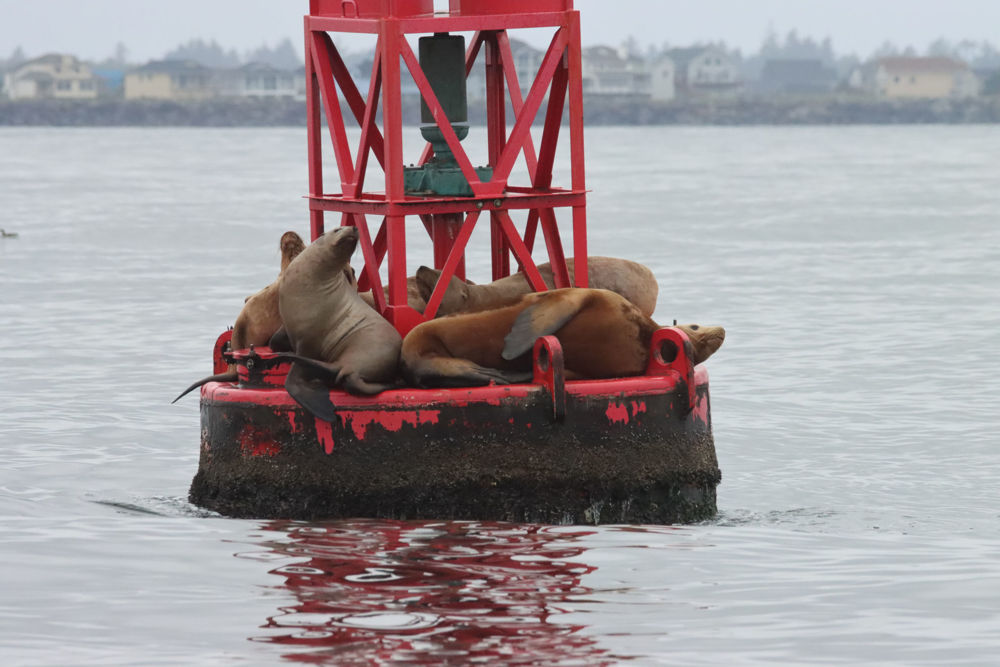
Steller's Sea Lions © Kevin Burke
We hit the ground running on our first full day. Our first stop was a good one. The mouth of the Cedar River where it meets Lake Washington is typically good for shorebirds. We were greeted there by a mob of birders looking over the mud flats. A Ruff had appeared overnight, and we got to enjoy it as one of the first birds of the trip. The Ruff was one of ten shorebird species there in the morning. A Red Knot and Stilt Sandpiper were also present and fairly uncommon for the area. Next, we headed to Kent, Washington on the banks of the Green River, where California Scrub-Jays, Willow Flycatcher, and Western Warbling Vireo were seen. After a nice lunch in West Seattle, we birded around Alki Beach and got our first looks at Pelagic Cormorant; we also had a nice encounter with a large flock of Bushtits. We finished off the day at Lincoln Park, where we encountered Chestnut-backed Chickadees, the very dark Northwestern Song Sparrows, and Steller's Jays. It was a full day that set the bar high for the rest of the trip.
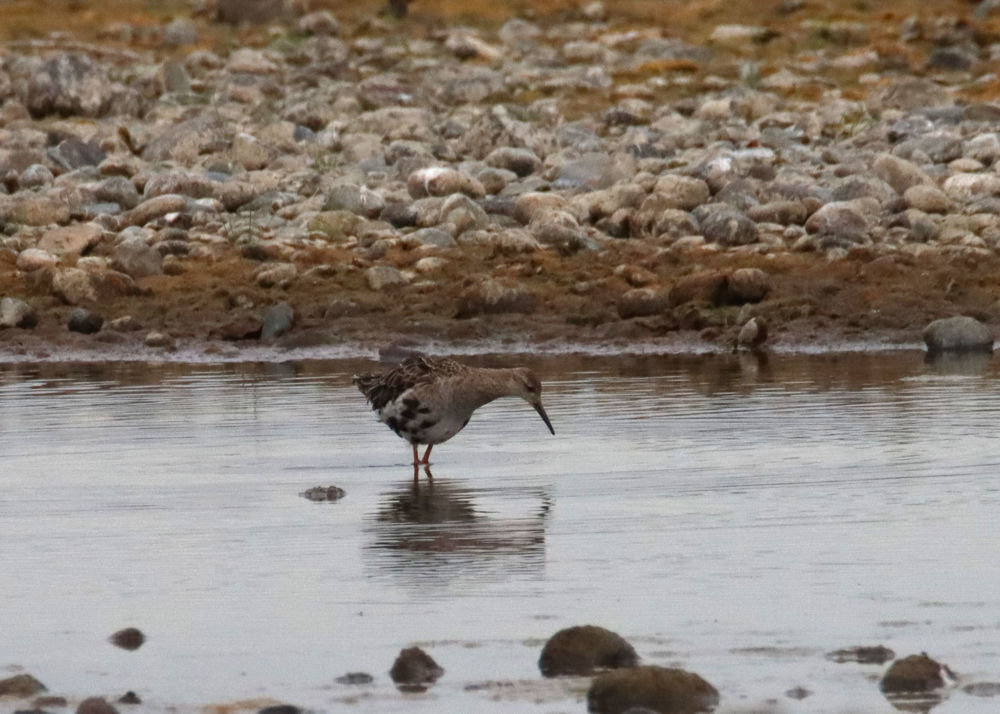
Ruff © Kevin Burke
The next morning we said goodbye to the Seattle area and headed to the outer coast. We spent most of the morning at the Billy Frank Jr. Nisqually National Wildlife Refuge. This is one of my favorite places to go birding. Fields, woods, marshes, and a tidal river make the bird life here very diverse. A Merlin and Kestrel bothered each other over the open fields and made for a great show. Nine Bald Eagles were counted perching on snags and hunting over the river. We encountered two Soras in the marsh near the dyke trail. As we were enjoying them, an American Bittern flew in over our shoulders and landed in the open giving extended views. This was a big target for the trip for a few people, so to see it so well was extra special. After lunch in the Olympia area, we traveled west to the coast. A stop at Bottle Beach yielded the biggest surprise of the trip, a Chestnut-sided Warbler well out of range. Part of the reason why birding is so exciting is that you never know what you are going to find. A quick final stop at the Westport Marina gave us our first glimpse of the Pacific Ocean.
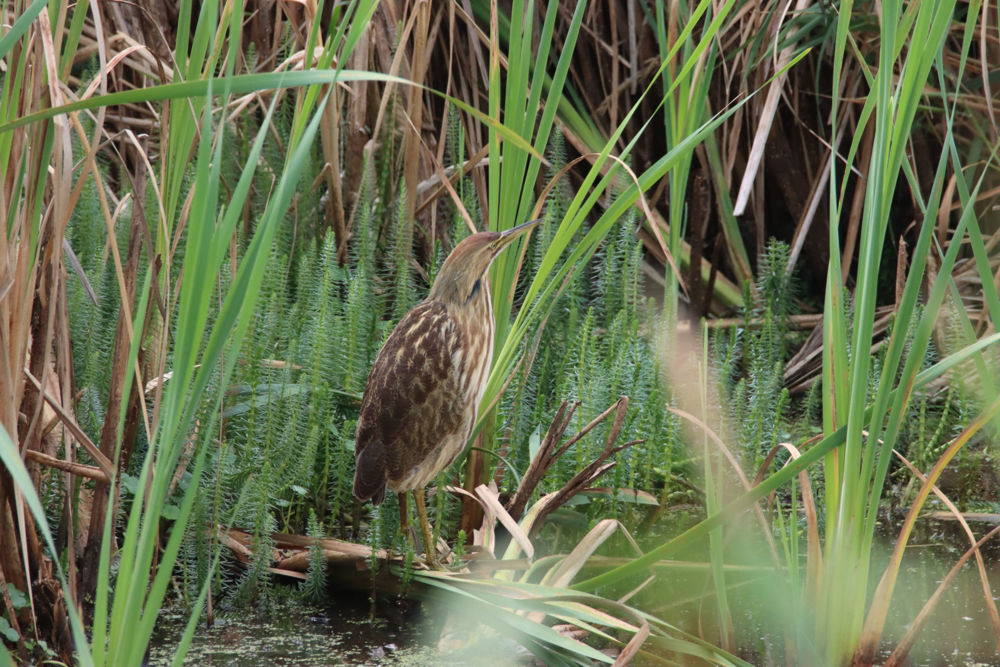
American Bittern © Kevin Burke
A full day of coastal birding was in store today. Westhaven State Park is right in Westport and always worth checking. We had Red-necked Grebe and Red-throated Loon fairly close to shore. The striking Heermann's Gulls were ever-present. Next, we strolled through the marina in Westport. There is a long boardwalk that extends on the outer wall of the marina. California Sea Lions played in the water. A large group of around two hundred Marbled Godwits foraged at the water's edge. We also saw the boat that we would go on the next day for our pelagic trip, the Monte Carlo. The small community of Tokeland was our next destination. Tokeland is typically home to a large number of Marbled Godwits and sometimes a Bar-tailed Godwit. We lucked out in seeing both! We estimated the Marbled Godwit flock at fifteen hundred birds, and there were three Bar-tailed Godwits mixed in. A dark Peale's Peregrine Falcon buzzed the flock, and they all got up together. It was amazing to see all those birds fly together. Lunch at the Wandering Goose was a nice surprise—an eclectic hotel with a great restaurant and wild decor. Westport Jetty rounded out our day with good looks at Rhinoceros Auklet.
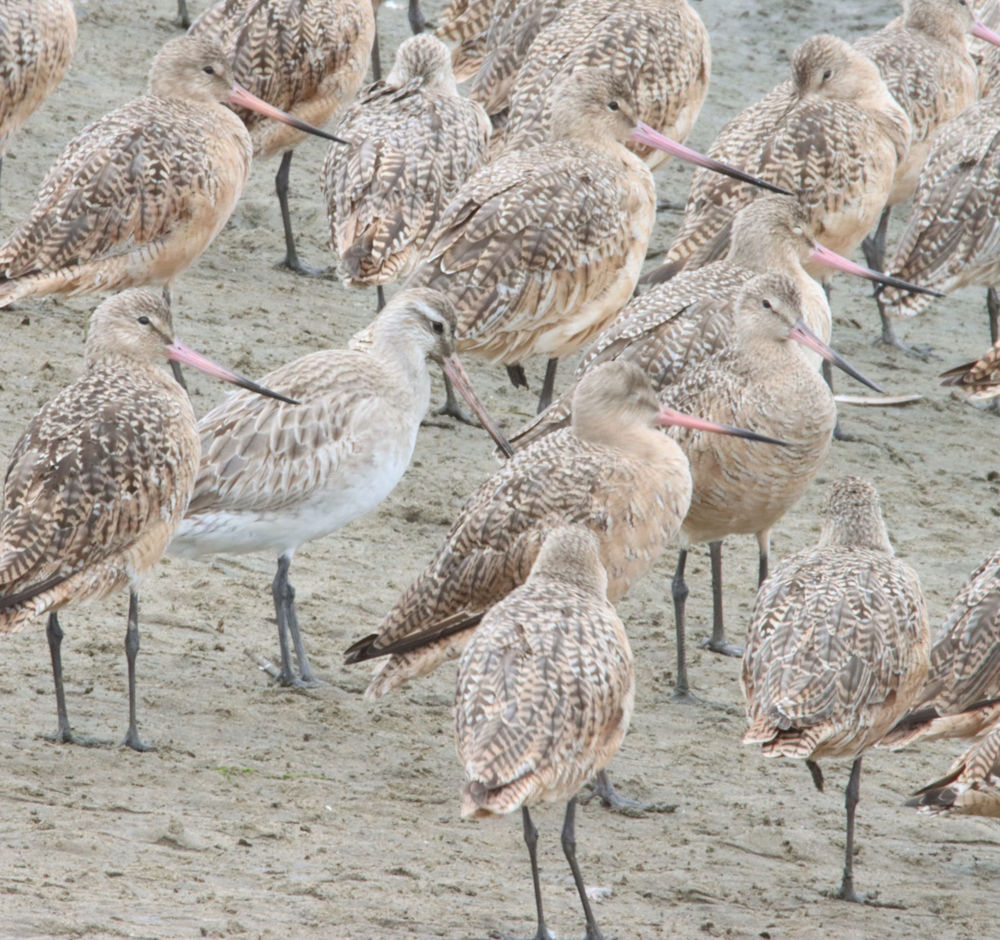
Bar-tailed and Marbled Godwit © Kevin Burke
Pelagic day was here! We headed out on the Monte Carlo today with Captain Phil and first mate Kris. We left the marina in the dark and motored out to the open ocean. I love days like this—so much anticipation. Steller's Sea Lions were lazing on the buoys as we headed out. The first pelagic birds we saw were Sooty Shearwaters. First one, then another, and by the end of the day we had seen several hundred. The next tubenoses were the Pink-footed Shearwaters. Red and Red-necked phalaropes dodged the boat as we motored on. Soon we started to get into some Sabine's Gulls on the water and flying around. Several were being harassed by a Long-tailed Jaeger. A fairly large gathering of Black-footed Albatross was a highlight. They were sitting on the water, resting. Short-tailed Shearwater, Fork-tailed Storm-Petrel, and South Polar Skua all gave good looks. The highlights kept coming with the beautiful Buller's Shearwater and dark morph Northern Fulmars coming close to the boat. There were just too many highlights today. This pelagic trip is a big reason why people sign up for this tour, and it didn't disappoint. We had a wonderful fun-filled dinner back at the Wandering Goose to recap the day.
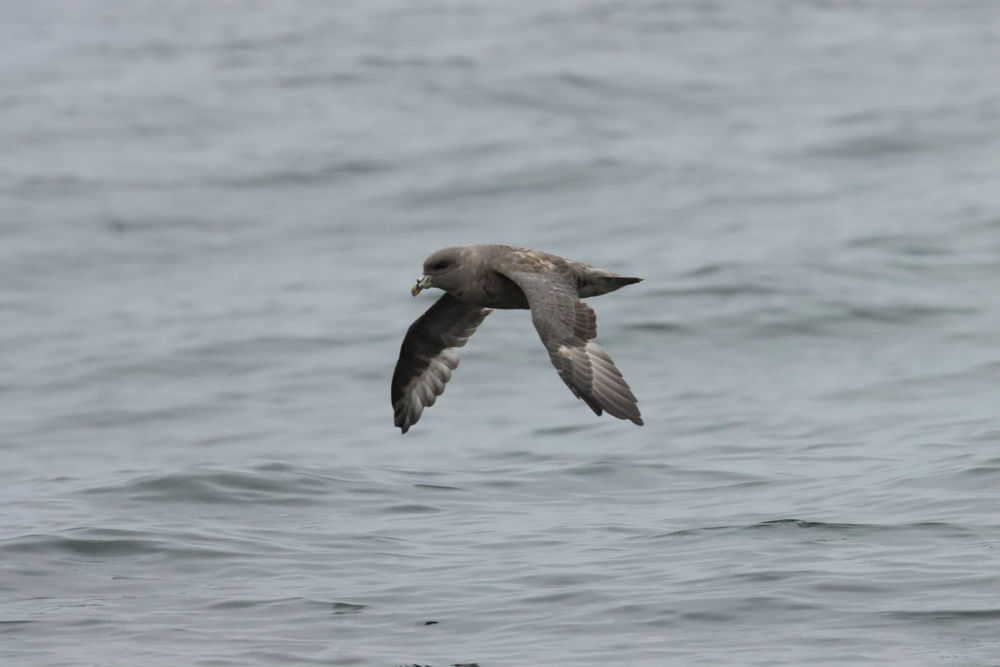
Northern Fulmar © Kevin Burke
There was more to see! Today was a travel day from Westport to Port Angeles. A quick stop at the Hoquiam Sewage Treatment Ponds was fruitful. We had a good study of a single Red-necked Phalarope that was floating close by. Several duck species were present, including Hooded Merganser and Northern Pintail. A small flock of American Pipits were foraging on the dirt nearby. From here we headed north to the Olympic National Park beaches. Ruby Beach is one of my personal favorite places on the planet. The sea stacks and driftwood are really special. We picked out some Surfbirds on one of the rocks and Surf Scoters in the surf. We stopped at Cascade Lake in the afternoon for the beautiful view and wonderful looks at Pacific Wren. It was a day full of driving and beautiful scenery. We checked into the Olympic Lodge in Port Angeles, where we would be for the next two nights.
The next morning was another big day of the trip. We headed out early to go to Hurricane Ridge in Olympic National Park. The seventeen-mile road up has plenty of pull-offs for great views, but the fog had other ideas. We did get great views of Red Crossbills feeding at eye level at one of the stops. The fog lifted at the top, so we had sweeping views of the Olympic Mountain Range. A huge flock of Band-tailed Pigeons flew overhead. A few Golden-crowned Sparrows gave good looks, and there were several charismatic Red-breasted Nuthatches feeding on cones. We had been up on Hurricane Ridge for a while and hadn't found the biggest target yet, so we decided to take a drive to another trailhead. It turned out that everyone else had that idea, too. The parking lot was full, so we retreated, and just before we got back to the main parking lot, there it was: a Sooty Grouse sitting on a snag. It stayed long enough for us to walk back down and get some photos. We spent the afternoon in the Sequim area in sight of Dungeness Spit—the world's longest natural spit, an impressive five miles long. We walked out to the base and birded along the way. Our last stop was at a large man-made spit in Port Angeles called Ediz Hook. On the log booms here we picked out Harlequin Ducks, American Herring Gulls, and Surf Scoters. A good way to end the day.
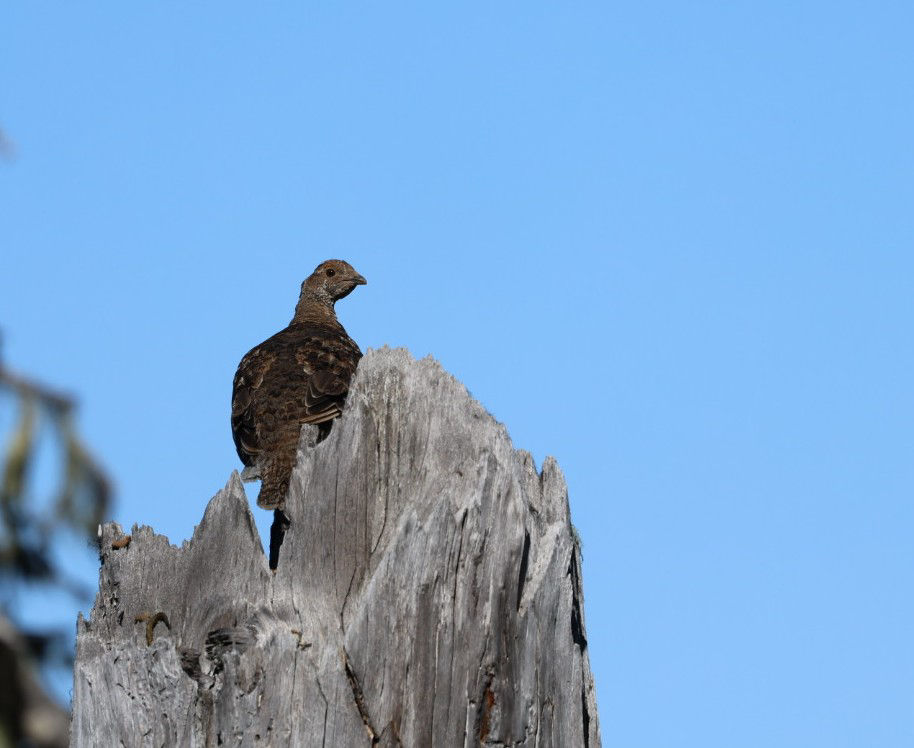
Sooty Grouse © Ida Williams
We headed to Anacortes and our last stop on the tour. Port Angeles treated us well. We made a last stop in the area at the Railroad Bridge Park and Audubon Center. This is a great place to find birds along the trail edges. We had to wait out a little rain, but once it subsided the birds came out. The feeders were full at the center. Chestnut-backed Chickadees, Red-breasted Nuthatches, and the coastal race of Downy Woodpecker all came in to feed. We found the Sooty Fox Sparrow, Purple Finch, and Bushtits along the trail. Black-throated Gray and Townsend's warblers were both seen near the feeders as well. We had lunch on the water in Port Townsend and enjoyed looks at Pigeon Guillemot and Purple Martins. A ferry was required to get us to Whidbey Island. While birding from the ferry, the captain pointed out some distant Orca Whales. We finished the day near Anacortes at Channel Drive, a famous shorebird spot. We enjoyed looks at both Yellowlegs, Pectoral Sandpiper, and Least Sandpipers. The Northern Harriers put on quite a show, too.
The last full day of our trip was a good one! We started off at Wiley Slough, a tidal marsh along the Skagit River that has traditionally been excellent for birding. We enjoyed great views of Merlin, Western Tanager, Lincoln's Sparrow, and Short-billed Dowitcher to name a few. Then we stopped at Fir Island a couple of miles away and saw thousands of shorebirds feeding on an open mud flat. We spent the rest of the day on a whale-watching boat touring throughout the San Juan Island chain. We were treated to a nice boat ride with views of Fin Whale, Orca Whale, and Humpback Whales. A good number of Marbled Murrelets were in the inland waters. Once we got out to the southwest side of San Juan Island the sheer amount of gulls and alcids was astounding. Thousands of Common Murres and gulls were feeding on bait fish, with Rhinoceros Auklets and Pigeon Guillemots sprinkled in. It was truly an amazing sight. The final two birds of our trip were Black Turnstone and Short-billed Gulls while motoring back. It was a great way to round out our trip.
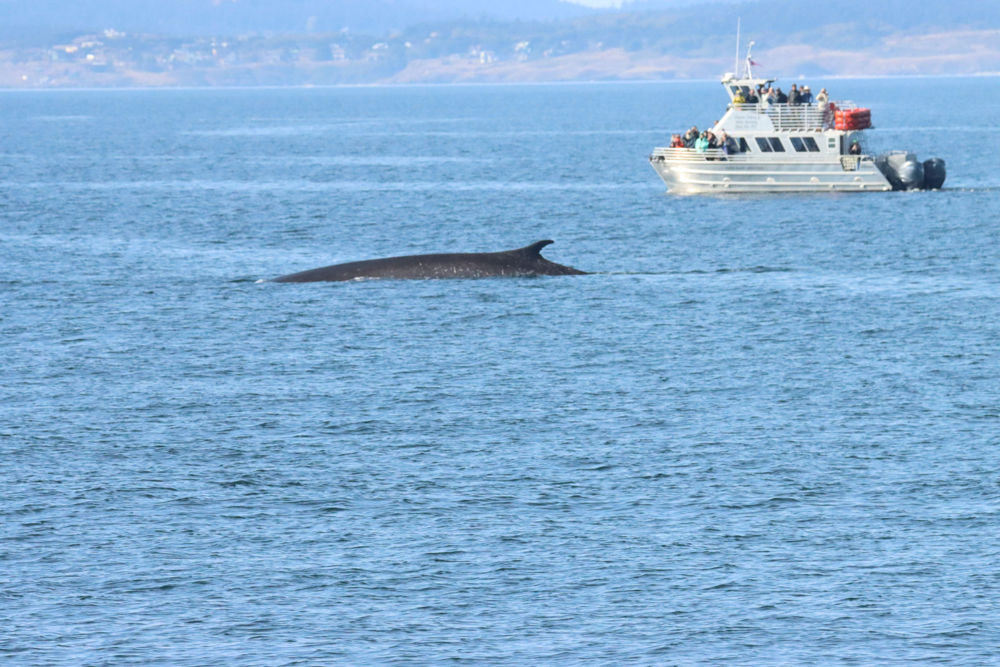
Fin Whale © Kevin Burke
This trip was full of great birds, great scenery, great people, and great food. The Pacific Northwest never fails to deliver on a great time. Starting our trip with a Ruff was special. The pelagic trip and Sooty Grouse encounter in the middle of the trip were unreal. And ending with a whale-watch with three different kinds of whales and so much sea life was the icing on the cake. I truly enjoyed the whole trip. The group voted on a "Bird of the Trip" and came up with Sooty Grouse, with Marbled Godwit and Chestnut-backed Chickadee coming in close behind.
A complete list of the birds recorded on our tour can be found at: eBird Trip Report
Description for the next departure of this tour.

